Related Research Articles
An anti-diarrhoeal drug is any medication which provides symptomatic relief for diarrhoea.

Diarrhea, also spelled diarrhoea, is the condition of having at least three loose, liquid, or watery bowel movements each day. It often lasts for a few days and can result in dehydration due to fluid loss. Signs of dehydration often begin with loss of the normal stretchiness of the skin and irritable behaviour. This can progress to decreased urination, loss of skin color, a fast heart rate, and a decrease in responsiveness as it becomes more severe. Loose but non-watery stools in babies who are exclusively breastfed, however, are normal.

A stomach rumble, also known as a bowel sound, peristaltic sound, abdominal sound, bubble gut or borborygmus, is a rumbling, growling or gurgling noise produced by movement of the contents of the gastro-intestinal tract as they are propelled through the small intestine by a series of muscle contractions called peristalsis. A trained healthcare provider can listen to these intestinal noises with a stethoscope, but they may be audible enough to be heard with the naked ear as the fluid and gas move forward in the intestines. The lack of bowel sounds is indicative of ileus, intestinal obstruction, or some other serious pathology.

Loperamide, sold under the brand name Imodium, among others, is a medication used to decrease the frequency of diarrhea. It is often used for this purpose in inflammatory bowel disease and short bowel syndrome. It is not recommended for those with blood in the stool, mucus in the stool, or fevers. The medication is taken by mouth.
Simeticone (INN), also known as simethicone (USAN), is an anti-foaming agent used to reduce bloating, discomfort or pain caused by excessive gas.
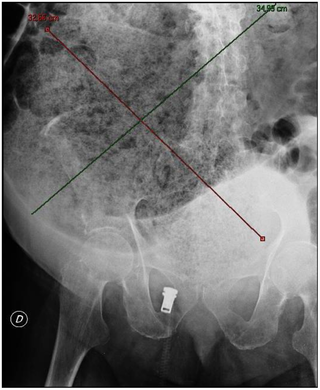
A fecal impaction is a solid, immobile bulk of feces that can develop in the rectum as a result of chronic constipation. A related term is fecal loading which refers to a large volume of stool in the rectum of any consistency. Fecal impaction is a common result of neurogenic bowel dysfunction and causes immense discomfort and pain. Treatment of fecal impaction includes laxatives, enema, and pulsed irrigation evacuation (PIE).
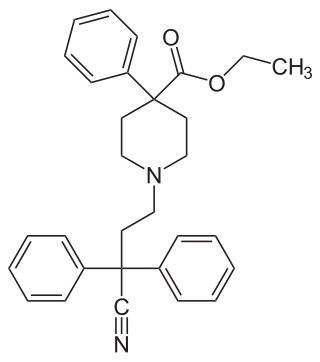
Diphenoxylate is a centrally active opioid drug of the phenylpiperidine series that is used as a combination drug with atropine for the treatment of diarrhea. Diphenoxylate is an opioid and acts by slowing intestinal contractions; the atropine is present to prevent drug abuse and overdose. It should not be given to children due to the risk that they will stop breathing and should not be used in people with Clostridium difficile infection.
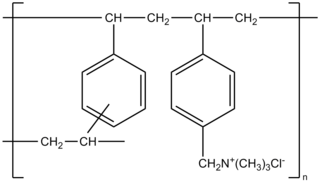
Colestyramine (INN) or cholestyramine (USAN) is a bile acid sequestrant, which binds bile in the gastrointestinal tract to prevent its reabsorption. It is a strong ion exchange resin, which means it can exchange its chloride anions with anionic bile acids in the gastrointestinal tract and bind them strongly in the resin matrix. The functional group of the anion exchange resin is a quaternary ammonium group attached to an inert styrene-divinylbenzene copolymer.
An antiflatulent agent is a drug used for the alleviation or prevention of excessive intestinal gas, i.e., flatulence.

Rifaximin, is a non-absorbable, broad spectrum antibiotic mainly used to treat travelers' diarrhea. It is based on the rifamycin antibiotics family. Since its approval in Italy in 1987, it has been licensed in over more than 30 countries for the treatment of a variety of gastrointestinal diseases like irritable bowel syndrome, and hepatic encephalopathy. It acts by inhibiting RNA synthesis in susceptible bacteria by binding to the RNA polymerase enzyme. This binding blocks translocation, which stops transcription. It is marketed under the brand name Xifaxan by Salix Pharmaceuticals.

Cefdinir, sold under the brand name Omnicef among others, is an antibiotic used to treat pneumonia, otitis media, strep throat, and cellulitis. It is a less preferred option for pneumonia, otitis media, and strep throat which may be used in those with a severe allergy to penicillin. It is taken by mouth.

Lubiprostone is a medication used in the management of chronic idiopathic constipation, predominantly irritable bowel syndrome-associated constipation in women and opioid-induced constipation. The drug is owned by Mallinckrodt and is marketed by Takeda Pharmaceutical Company.
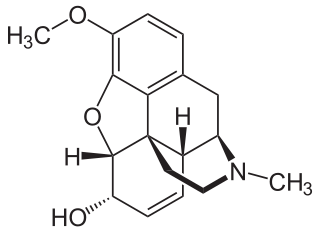
Codeine is an opiate and prodrug of morphine mainly used to treat pain, coughing, and diarrhea. It is also commonly used as a recreational drug. It is found naturally in the sap of the opium poppy, Papaver somniferum. It is typically used to treat mild to moderate degrees of pain. Greater benefit may occur when combined with paracetamol (acetaminophen) or a nonsteroidal anti-inflammatory drug (NSAID) such as aspirin or ibuprofen. Evidence does not support its use for acute cough suppression in children or adults. In Europe, it is not recommended as a cough medicine in those under 12 years of age. It is generally taken by mouth. It typically starts working after half an hour, with maximum effect at two hours. Its effects last for about four to six hours. Codeine exhibits abuse potential similar to other opioid medications.

Methylnaltrexone, used in form of methylnaltrexone bromide, is a medication that acts as a peripherally acting μ-opioid receptor antagonist that acts to reverse some of the side effects of opioid drugs such as constipation without significantly affecting pain relief or precipitating withdrawals. Because MNTX is a quaternary ammonium cation, it cannot cross the blood–brain barrier, and so has antagonist effects throughout the body, counteracting effects such as itching and constipation, but without affecting opioid effects in the brain such as pain relief. However, since a significant fraction of opioid analgesia can be mediated by opioid receptors on peripheral sensory neurons, particularly in inflammatory conditions such as arthritis, traumatic or surgical pain, MNTX may increase pain under such circumstances.

Difenoxin is an opioid drug used, often in combination with atropine, to treat diarrhea. It is the principal metabolite of diphenoxylate.

Racecadotril, also known as acetorphan, is an antidiarrheal medication which acts as a peripheral enkephalinase inhibitor. Unlike other opioid medications used to treat diarrhea, which reduce intestinal motility, racecadotril has an antisecretory effect — it reduces the secretion of water and electrolytes into the intestine. It is available in France and other European countries as well as most of South America and some South East Asian countries, but not in the United States. It is sold under the tradename Hidrasec, among others. Thiorphan is the active metabolite of racecadotril, which exerts the bulk of its inhibitory actions on enkephalinases.

Docusate is the common chemical and pharmaceutical name of the anion bis(2-ethylhexyl) sulfosuccinate, also commonly called dioctyl sulfosuccinate (DOSS). It is on the World Health Organization's List of Essential Medicines. Salts of this anion, especially docusate sodium, are widely used in medicine as laxatives and as stool softeners, by mouth or rectally. In 2020, it was the 163rd most commonly prescribed medication in the United States, with more than 3 million prescriptions. Some studies claim that docusate is not more effective than a placebo for improving constipation. Other docusate salts with medical use include those of calcium and potassium.

Naloxegol is a peripherally acting μ-opioid receptor antagonist developed by AstraZeneca, licensed from Nektar Therapeutics, for the treatment of opioid-induced constipation. It was approved in 2014 in adult patients with chronic, non-cancer pain. Doses of 25 mg were found safe and well tolerated for 52 weeks. When given concomitantly with opioid analgesics, naloxegol reduced constipation-related side effects, while maintaining comparable levels of analgesia.

Eluxadoline, sold under the brand names Viberzi and Truberzi, is a medication taken by mouth for the treatment of diarrhea and abdominal pain in individuals with diarrhea-predominant irritable bowel syndrome (IBS-D). It was approved for use in the United States in 2015. The drug originated from Janssen Pharmaceutica and was developed by Actavis.
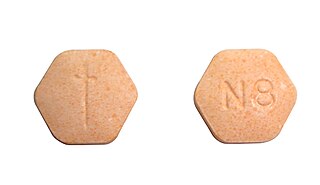
Opioid withdrawal is a set of symptoms arising from the sudden withdrawal or reduction of opioids where previous usage has been heavy and prolonged. Signs and symptoms of withdrawal can include drug craving, anxiety, restless legs, nausea, vomiting, diarrhea, sweating, and an increased heart rate. Opioid use triggers a rapid adaptation in cellular signalling pathways that means, when rapidly withdrawn, there can be adverse physiological effects. All opioids, both recreational drugs and medications, when reduced or stopped, can lead to opioid withdrawal symptoms. When withdrawal symptoms are due to recreational opioid use, the term opioid use disorder is used, whereas when due to prescribed medications, the term prescription opioid use disorder is used. Opioid withdrawal can be helped by the use of opioid replacement therapy, and symptoms may be relieved by the use of medications including lofexidine and clonidine.
References
- ↑ Imodium, drugs.com
- ↑ Simethicone, drugs.com
- ↑ "Bloody Diarrhea" . Retrieved 2013-02-11.
- ↑ "Imodium Product Page". Archived from the original on 2012-06-10. Retrieved 2012-06-19.